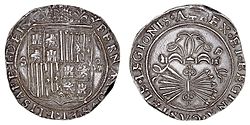
Back Spaanse mat (munt) Afrikaans دولار إسباني Arabic Ral de vuit Catalan Δολάριο Ισπανίας Greek Hispana dolaro Esperanto Real de a ocho Spanish دلار اسپانیایی Persian Pièce de huit French Real de oito Galician Dolar Spanyol ID
| ||||||
| ||||||
| ||||||
| ||||||
| ||||||
The Spanish dollar, also known as the piece of eight (Spanish: real de a ocho, dólar, peso duro, peso fuerte or peso), is a silver coin of approximately 38 mm (1.5 in) diameter worth eight Spanish reales. It was minted in the Spanish Empire following a monetary reform in 1497 with content 25.563 g (0.8219 ozt) fine silver. It was widely used as the first international currency because of its uniformity in standard and milling characteristics. Some countries countermarked the Spanish dollar so it could be used as their local currency.[1]
Because the Spanish dollar was widely used in Europe, the Americas, and the Far East, it became the first world currency by the 16th century.[2][3][4]
The Spanish dollar was the coin upon which the original United States dollar was based (at 0.7735 troy ounces or 24.06 grams), and it remained legal tender in the United States until the Coinage Act of 1857. Many other currencies around the world, such as the Japanese yen and the Chinese yuan, were initially based on the Spanish dollar and other 8-real coins.[5] Most theories trace the origin of the "$" symbol, which originally had two vertical bars, to the pillars of Hercules wrapped in ribbons that appear on the reverse side of the Spanish dollar.[6]
The term peso was used in Spanish to refer to this denomination, and it became the basis for many of the currencies in the former Spanish viceroyalties, including the Argentine, Bolivian, Chilean, Colombian, Costa Rican, Cuban, Dominican, Ecuadorian, Guatemalan, Honduran, Mexican, Nicaraguan, Paraguayan, Philippine, Puerto Rican, Peruvian, Salvadoran, Uruguayan, and Venezuelan pesos. Of these, "peso" remains the name of the official currency in the Philippines, Mexico, Cuba, the Dominican Republic, Colombia, Chile, Argentina, and Uruguay.
- ^ "Dissemination of Hispanic-American coinage". Encyclopædia Britannica. Archived from the original on 29 December 2011. Retrieved 7 February 2012.
- ^ Woodcock, Ray (1 May 2009). Globalization from Genesis to Geneva: A Confluence of Humanity. Trafford Publishing. pp. 104–105. ISBN 978-1-4251-8853-5. Archived from the original on 10 February 2024. Retrieved 13 August 2013.
- ^ Thomas J. Osborne (29 November 2012). Pacific Eldorado: A History of Greater California. John Wiley & Sons. p. 31. ISBN 978-1-118-29217-4. Archived from the original on 10 February 2024. Retrieved 13 August 2013.
- ^ Davies, Roy. "Origin and history of the world dollar and dollar sign". Archived from the original on 6 June 2023. Retrieved 29 January 2019.
- ^ Babones, Salvatore (30 April 2017). "'The Silver Way' Explains How the Old Mexican Dollar Changed the World". The National Interest. Archived from the original on 1 October 2023. Retrieved 15 April 2019.
- ^ Cordingly, David (1996). Under the Black Flag: The Romance and the Reality of Life Among the Pirates. Random House. p. 36. ISBN 9780679425601.




